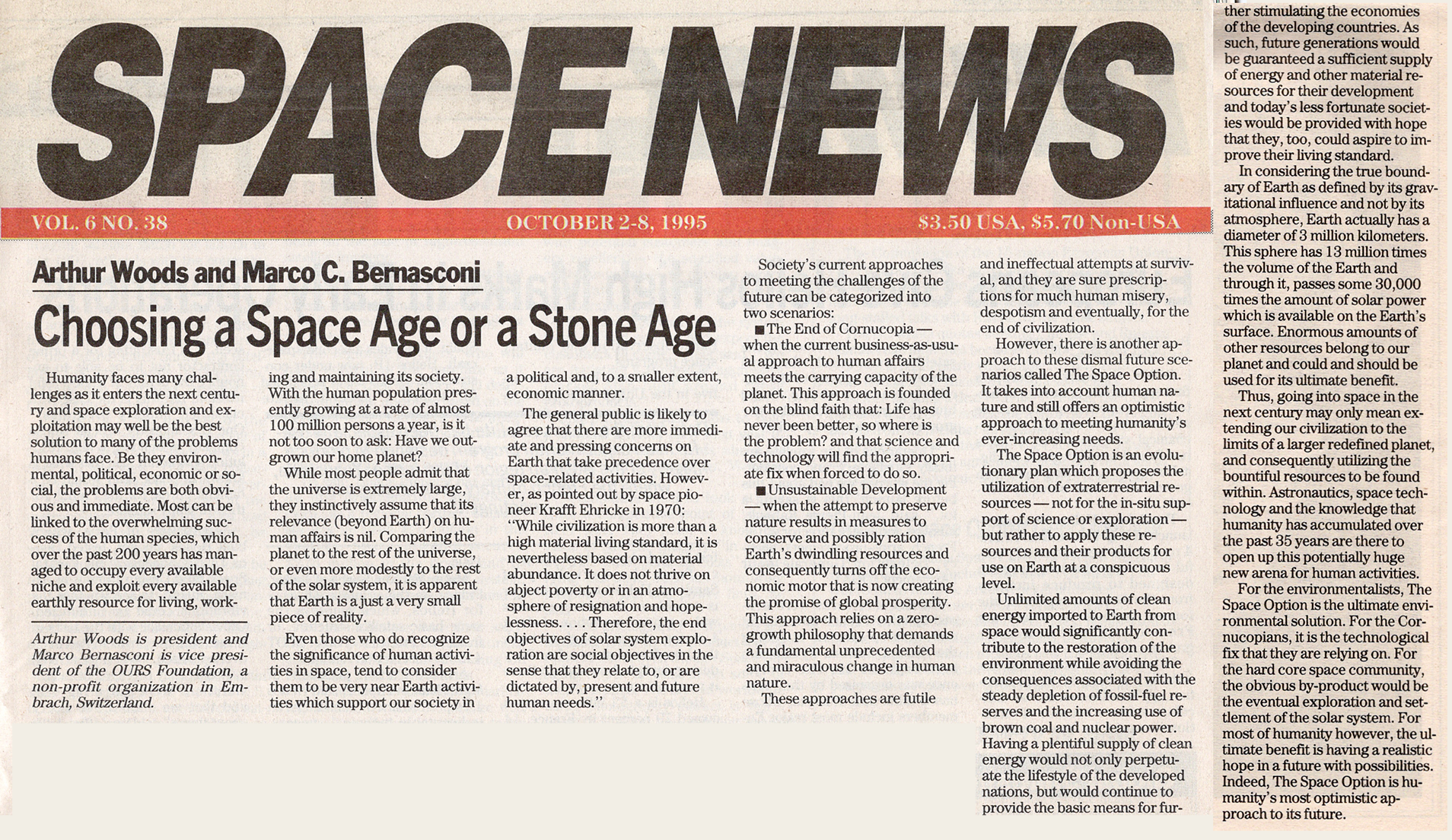This commentary by Arthur R. Woods and Marco C. Bernasconi is a slightly updated version which first appeared in Space News – Oct. 2- 8, 1995
There is no need to list the many challenges facing humanity as it enters the next century. Be they environmental, political, economic or social, the problems are both obvious and immediate. Most can be linked to the overwhelming success of the human species over the past 200 hundred years – a success that has resulted in it occupying every available niche and exploiting every available earthly resource for living, working and maintaining its society. With the human population presently growing at a rate of almost 100 million persons a year, is it not too soon to ask a fundamental question: “Has humanity outgrown its home planet Earth?”
While most people do acknowledge – at least on an intellectual level – that the Universe is extremely large, they instinctively assume that the relevance of the Universe (beyond Earth) on human affairs is nil. Comparing our physical planet to the rest of the Universe, or even more modestly to the rest of the Solar System, it is apparent that Earth is a just a very small piece of reality. Therefore, if one considers the Universe, its potential significance for our common future is proportional to the ratio between it and our small planet with its finite and rapidly disappearing resources. Thus, human destiny on Earth is irrevocably linked to human destiny in space.
Even those who do recognize in some way the significance of human activities in space, tend to consider them to be very “near Earth” activities which support our current society in a political and, to a smaller extent, economic manner. As a consequence, even this group would value space development and astronautics as a human activity to be developed within the context of the available financial resources. Most people in the general public would likely agree that: On Earth there are more immediate and pressing concerns and that, as an important area for human activity, space is a luxury that society can postpone. However, as pointed out by space pioneer Krafft Ehricke in 1970 (1):
“While civilization is more than a high material living standard, it is nevertheless based on material abundance. It does not thrive on abject poverty or in an atmosphere of resignation and hopelessness. It needs vigor as well as vision. Therefore the end objectives of solar system exploration are social objectives in the sense that they relate to, or are dictated by, present and future human needs.”
An analysis of society’s current approaches to meeting the challenges of the future can be categorized into two scenarios:
- The End of Cornucopia – when the current business-as-usual approach to human affairs meets the carrying capacity of the planet. This approach is founded on the blind faith that Life has never been better – so where is the problem? and that science and technology will find the appropriate fix when it is forced to do so.
- Unsustainable Development – when the real concern and reflexive drive to preserve nature results in measures to husband and eventually, to ration Earth’s dwindling resources and consequently turns off the economic motor that is now creating the promise of global prosperity. This approach relies on a zero-growth philosophy that demands a fundamental change in human nature – a change which will miraculously occur when humanity wakes up to the fallacy of its exploitative ways.
Both of these approaches to the future are futile and ineffectual attempts at survival, and both are sure prescriptions for much human misery, despotism and eventually – for the end of civilization. Considering the number of human beings that are expected to be around in the next 25 years – 8 billion or so – the beginning of the end of our civilization may be only a generation away.
However, there is another approach to these dismal future scenarios. Called “The Space Option” it takes into account human nature and still offers an optimistic approach to meeting humanity’s ever increasing needs. It is an option that appeals strongly to the human spirit by offering a creative and realistic approach to meeting and solving many of our civilization’s impending problems.
The Space Option is an evolutionary plan to significantly meet the basic and anticipated needs of human societies on Earth through the utilization of extraterrestrial resources – not only for the in-situ support of science or exploration – but rather to apply these resources and/or their products for use on Earth at a conspicuous level.
Obviously energy from space is central to the implementation of The Space Option. Unlimited amounts of clean energy imported to Earth from space would significantly contribute to the restoration of the environment while avoiding the environmental and political consequences associated with the steady depletion of our fossil fuel reserves and the increasing use of brown coal and/or nuclear power. Having a plentiful supply of clean energy would not only perpetuate the lifestyle of the developed nations, but would continue to provide the basic means for further stimulating the economies of the developing countries. As such, future generations would be guaranteed a sufficient supply of energy and other material resources for their development and today’s less fortunate societies would be provided with hope that they, too, could aspire to improve their living standard beyond their present situation.
If one considers the true boundary of Earth as defined by its gravitational influence and not by its atmosphere, then Earth actually has a diameter of 3 million km. This sphere has 13 million times the volume of the physical Earth and through it, passes some 50,000 times the amount of solar power which is available on the surface of Earth. Enormous amounts of other resources, including the Moon, are located within the borders of this larger and richer planet. Like the territorial waters surrounding nations – these resources belong to our planet and could and should be used for its ultimate benefit.
Thus, going into space in the next century may only mean extending our civilization to the limits of a larger redefined planet Earth and consequently utilizing the bountiful resources to be found within. Astronautics, space technology and the knowledge that humanity has accumulated over the past 50 years are there to open up this potentially huge new arena for human activities.
For the environmentalists, The Space Option is the ultimate environmental solution. For the Cornucopians, it is the technological fix that they are relying on. For the hard core space community, the obvious by-product would be the eventual exploration and settlement of the solar system. For most of humanity however, the ultimate benefit is having a realistic hope in a future with possibilities. Indeed, The Space Option is humanity’s most optimistic approach to its future.
Our civilization is at its peak – we have the means today to implement The Space Option but not yet the commitment. However, if our species does not soon embrace this unique opportunity with sufficient commitment, it may miss its one and only chance to do so. Humanity could soon be overwhelmed by one or more of the many challenges it now faces. The window of opportunity is closing as fast as the population is increasing. In the 21st century, the main challenge to the space community will be informing and then convincing the public of the viability of The Space Option as the only optimistic alternative to the other current approaches to human destiny because our future will be either “A Space Age or a Stone Age”.
- Krafft A. Ehricke, (1970). In-Depth Exploration of the Solar System and Its Utilization for the Benefit of Earth. Annals New York Academy of Sciences 187, 427-456.






